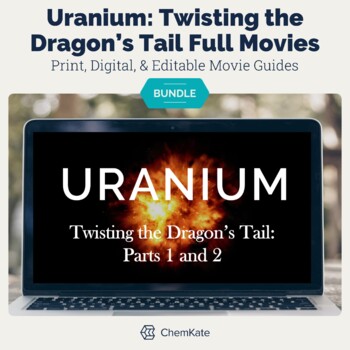Uranium Twisting the Dragon's Tail Movie Guides Bundle of Parts 1 and 2
- Zip
- Google Apps™

What educators are saying
Products in this Bundle (2)
Also included in
- Science movie guides for middle or high school science just became more amazing with these self-grading digital, editable, and printable question movie guides for you or subs. PBS science movies keep your students engaged, bring content to life, learn beyond the textbook, and provide teachable momenPrice $33.49Original Price $41.93Save $8.44
Description
Watching the PBS Uranium: Twisting the Dragon's Tail movies as Derek Muller explores uranium, one of the world's most controversial elements of nuclear chemistry, just became more amazing with these self-grading digital, editable, and printable 40 - 47 question 2 movie guides bundled at a 20% discount. Twisting the Dragon's Tail movies keep your students engaged, brings content to life beyond the textbook, and provides teachable moments with a wide variety of interest-building nuclear topics. Each editable guide can be broken into individual portions or shown as a whole. Even if a movie can't be shown in one class period, the Google form will keep students' answers for you! Great for middle through high school, regular or sub days. These movies can often be streamed for free from local libraries, such as through Hoopla, as well as commonly purchased on the PBS site.
✦ This, along with other science movies are available in my time and costs-savings Science Movie Guides Bundle ✦
Each guide includes:
- 40 - 47 question self-grading and editable Google forms with times marked for each section
- PDFs of movie worksheets and answer keys
- Google slides of editable movie worksheets, which can be downloaded in various formats, such as Microsoft
Movies/Documentaries included:
- Uranium: Twisting the Dragon's Tail Part 1: The Rock that Became a Bomb (1 hr)
- Uranium: Twisting the Dragon's Tail Part 1: The Rock that Changed the World (1 hr)
Documentary Synopsis from PBS
Born from the collapse of a star, uranium has brought hope, progress, and destruction. It has revolutionized society, from medicine to warfare. It is an element that has profoundly shaped the past, will change the future, and will exist long after humans have left the Earth. (Source: PBS.org)
About the Show from PBS:
Legend says that there is a world beneath this one. Some say that it is there where "the Dragon" sleeps. Warm, coiled, ready to spring - the Dragon is rumored to breathe fire, her wings capable of enveloping the Earth. Many are advised to be careful to not wake the Dragon.
Join us on an epic adventure - a journey through place and time - around the cultural, scientific, and natural history of the most wondrous, and terrifying, rock on Earth: Uranium.
Uranium was created violently, with the collapse of a star long ago. A massive explosion, a supernova - this was the birth of our solar system. Uranium is woven throughout the fabric of our Earth, and it still crackles with the heat and violence of that creation.
Uranium spits energy, unlike any other rock. Its energy transforms DNA and shapes the very nature of what it means to be human. You are who you are because of Uranium.
Uranium is a changeling. Leave a lump of it alone, and when you return, it will have turned into something else — all by itself. Uranium is a shape-shifter that transforms itself into new forms: a goblin rock that plays tricks, the greatest of which is to transform itself into a force in politics, culture, economics, and terror. This rock, considered worthless, transforms itself into the most desirable, the most expensive, and the most feared substance on Earth. In a warming world, Uranium may yet transform again into our savior as a source of clean, limitless power. Be careful how you wake the Dragon.
Our program is a journey with host and physicist, Dr. Derek Muller. Muller addresses counter-intuitive concepts in science, and he’s been featured in Scientific American, Wired, Mashable, Gizmodo, and i09. He has a historian’s passion for detail, a physicist’s knowledge, and a talent for finding great stories. He’s packed a suit, a tie, and hiking boots. He’ll need both for where he’s going - down mine-shafts, across arid deserts, into quiet libraries, up ivy-covered towers, and through the vast silence of a city abandoned after the world’s worst nuclear accident.
This is the extraordinary, untold story of Uranium. (Source: PBS.org)
You may also like:
•Main Group Periodic Table Battleship - a fun game of main group element patterns
•Chemistry I Digital Task Cards - a wide variety of self-grading Boom cards and interactive Google slides
•Classifying Matter Maze - Particle-diagram classification of matter in a self-correcting maze
Interested in more?
Mole and Stoichiometry Resources
● Be sure to follow my store to be alerted of new products: CLICK HERE
● Did you know that you can receive credit towards future TpT purchases by reviewing this product? Please help my store grow by leaving a review on the product page or through "My Purchases" under "My Account" at TpT. I enjoy making products to help you be successful in the classroom, so if you have any other questions or suggestions, please contact me KateCk@chemkate.com or in the "Ask a Question" tab above.





